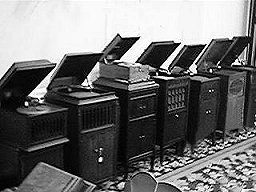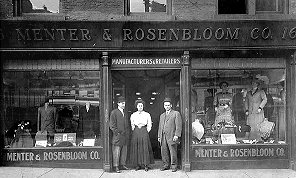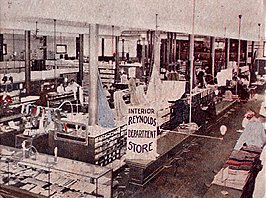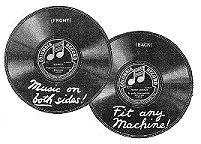|
More 1910s topics Nostalgia Cafe main page |
1910s Shopping====================================================================== ====================================================================== ====================================================================== | ||
|
Shopping | ----- |
Department stores had everything....dresses and suits, hats, fabrics, accessories, housewares and furnishings. When you went shopping, the floorwalker directed you to the proper department, where the sales clerk provided you with the ultimate in personal service. When you paid for your item, a rope-and-pulley system carried your money up to the cash office in a small basket. The cashier made change and issued a receipt, which was carried back down to the sales counter in the basket.  Newman's Department Store Joplin, Missouri, 1915 | ||
| ======================================== ======================================== | ======================================== ======================================== | |||
music stores The sale of music-related merchandise was big business. In addition to phonographs and records, music stores sold pianos, organs, brass instruments, piano rolls and sheet music. Thousands of stores sold phonographs as a sideline. General stores, hardware stores, jewelers and even drugstores became Victor, Columbia and Edison authorized dealers. Victor had 10,000 authorized dealers all across the country during the 1910s.
Victor dealers demonstrated their new records on the 28th of each month. You could use one of the phonographs on display to listen to a record before you bought it. The walls featured portraits of the most popular Victor recording artists of the day, including Enrico Caruso, Nellie Melba and Amelita Galli-Curci.
|  Phonographs for sale Most of the music we enjoyed in the 1910s was played at home on the piano. Getting together for a sing-along was fun for everyone. This made sheet music extremely popular. Broadway showtunes, parlor songs and marches were all the rage. If you didn't know the tune, the music store employees would play and sing it for you.  Piano rolls If you lacked musical skill, a player piano, or pianola, would do the playing for you. The most popular songs of the day were all published as piano rolls, which were kept in individual cardboard boxes. Catalogs listed the song title and composer, as well as the original pianist who cut the master roll. | |||
| ======================================== ======================================== | ======================================== ======================================== | |||
groceries In a traditional grocery store, the products were kept in glass cases or on shelves behind the counter. You gave your shopping list to the clerk, who obtained the items for you. This practice limited the customer's choices and kept the average store relatively small.  Piggly Wiggly | In 1916, a new idea in grocery shopping was born. Memphis was the site of the first grocerteria: a self-service market opened by Clarence Saunders and given the unusual name "Piggly Wiggly." Shoppers were sent down a single aisle, which zig-zagged through the store like a maze. They were free to choose their own products, which they placed in a basket they carried on their arm. This arrangement had three results...1) individually-packaged products were favored and bulk products in barrels were phased out, 2) stores gradually increased in size, and 3) shoppers walked past every product in the store, which introduced the new concept of impulse buying. The Piggly Wiggly chain spread very quickly. By 1920, there were 500 locations across the country. | |||
| ======================================== ======================================== | ======================================== ======================================== | |||
 Fashions for men and ladies at Menter & Rosenbloom other stores dress shops general stores dry-goods stores milliners shoe stores newsstands |  Men's clothing  The newsstand sold magazines, newspapers, cigars and candy | |||
return to the 1910s main page

